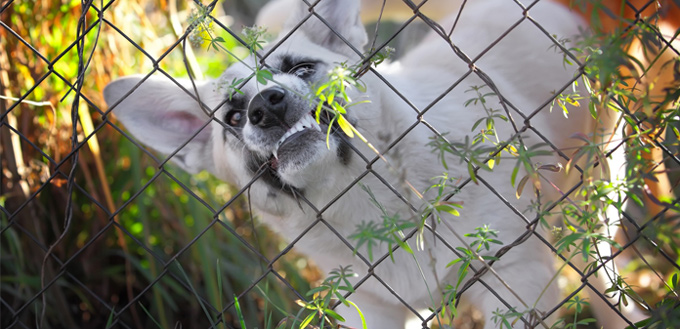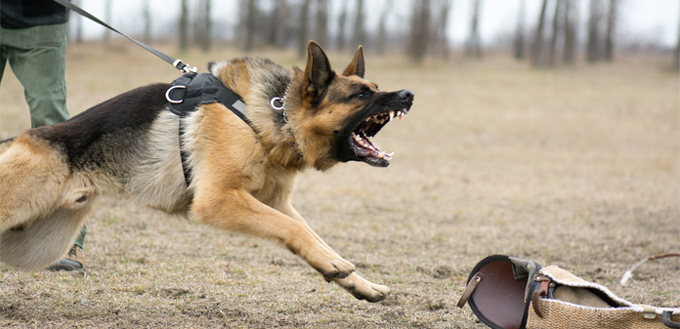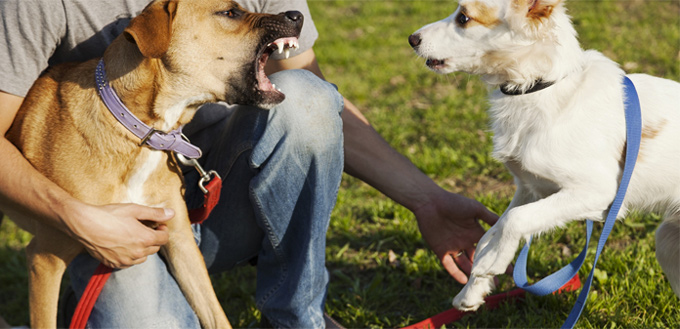Resource guarding is something that all dog owners worry about. It not only affects your relationship with your beloved pet, but also can affect how others react to your dog. Resource guarding can take many forms and is best dealt with early. But, what exactly is resource guarding, what causes it, and how can you best stop it? These are just some of the questions we explore here.
What is Resource Guarding?
Some of the most common examples of resource guarding include:
- Your dog growling as you pass close to them while they are chewing on a bone or a toy.
- Snarling or barking as people, including children, pass them while they are eating.
- Becoming protective of a specific place in the house where they like to lay and letting out warning growls if you try to move them.
In short, resource guarding is categorized by growling, snapping, barking or other displays of aggression by a dog meant to convince humans or other animals to stay away from the resource that they are guarding.

The resource can be pretty much anything including toys, treats, bones, food, bed and sleeping areas, or places in the home that they consider theirs. Dogs often guard these items or places from animals as well as humans. Here we are focusing on resource guarding from humans.
You May Also Like: Dog Beds
Why do Dogs Guard Resources?
Unfortunately, there is no simple answer to this question. All mammal resource guard to some extent, including humans. We lock doors, set alarms, write our names on thing, and use passwords to protect what is ours. It is a natural response to protect the things that are important to us and which we have had to work to get.
In the wild, the canines that are most able to protect their resources – such as food and territory are those that live the longest and go on to produce the healthier offspring. It is part of their natural survival instinct.
While they may use delicate body language signs to provide warnings, aggressive behaviors are the easiest way for these animals to communicate with others that they do not tolerate attempts to endanger their survival by stealing these resources.
So, part of the answer is that resource guarding is a genetic link between our modern-day family pets and their wild ancestors. But, there is more to it than that. Early life experiences also have an effect, as does the relationship between owner and dog.
Resource guarding is most common in puppies. It generally reduces or disappears as they are taught that the behavior is unacceptable and as they realize that there is no need for the behavior as they do not need to fight for scarce resources. If this education is missing or resources are scarce during their formative years, then problems can occur and can escalate as they grow.
Solving Resource Guarding
If your four-legged friend suddenly starts resource guarding, then the first thing you need to do is find out why they are displaying these behaviors. There are a range of reasons why this behavior may suddenly appear in a dog that has never displayed such issues before. Ask yourself the following questions, before you look at more complex solutions:
- Is your dog sick?
If your dog is feeling poorly or is in pain, they are also under stress, which can cause changes in behavior. Always rule out medical conditions first.
- Is your dog hungry?
If they are not getting enough food to eat, then it follows that they are likely to be more protective of bones, treats, and food. Remember it is not just about the amount of food they get, but also the quality of that food.
You May Also Like: Dog Treats
- Is your dog getting enough physical exercise?
Not getting enough exercise can cause a range of negative behaviors in your dog and not all of them are obvious. Dogs need regular physical activity including walking and playing.
- Is your dog mentally stimulated?
Dogs do not like being bored any more than we do. While boredom is generally associated with destructive behaviors, it can show in other ways, including guarding behaviors.
Do You Need Professional Support?
Before looking at solutions to guarding it is important to note that if your dog’s behavior has put you or anyone else at serious risk, then you need professional advice straight away regardless of the possible cause. If you do not know where to source such support, then talk to your veterinarian. However, if your dog’s guarding has not got to this stage, then it is usually something you can deal with at home.
Challenging and Changing Guarding Behavior
If you are not in the position outlined above and you have discounted the issues outlined previously, then it is time to look at how you can approach and change your dog’s behavior. This involves changing their internal response to people trying to take away the resources that they are guarding.
To achieve this, you need to work with your dog to understand that you are not a threat to them and that their behaviors will not have the desired effect of keeping you away. The best way to achieve this is through a desensitization and counter conditioning approach.
- Achieving Desensitization
Desensitization involves steadily exposing your canine companion to situations where they would usually resource guard without provoking the unwanted response.
This is achieved by introducing the stimulus at a very low intensity or distance so that a response is not triggered. In this situation the stimulus is the person approaching the dog and the item being guarded. Then, gradually increasing the amount of stimulation over time and over numerous sessions.
- Achieving Counter Conditioning
This method changes negative responses to a stimulus into the desired behavior by creating positive associations. Positive associations require a reward, high-value food rewards work well with the majority of dogs. If food does not work, you need to find another high-value reward.

It is important that you approach this method with an understanding that it does not work over night. It takes time and patience to change behaviors and you may need to revisit steps more than once to achieve the desired end result.
- Begin by listing everything your dog guards as a resource and be very specific.
- Observe your dog around these items. Make a note of how they react when someone approaches them and again be as specific as you can. This should be carried out over several weeks to give the clearest possible picture.
- Find a high-value treat or reward. This must be something that has equal or preferably greater value to your dog than the item they are guarding.
- Create a potential guarding situation. Once your dog is settled with the item that elicits the guarding response leave the room. When you come back in do not get close enough to elicit the guarding behavior. From your position, throw a treat to your dog – repeat several times to ensure they take note of what is happening.
- If they leave their spot to ask for more treats, ensure you ignore them. It is important that they make the association between the item they were enjoying, but not showing guarding behaviors with, and the arrive of positive treats or rewards.
- Repeat this process several times before moving onto the next step.
- The next step is to move closer to your dog and repeat the process. Move one step closer, throw the treat, and then step back. Repeat and then leave the room. If your dog becomes uncomfortable or stiffens during this process, stop immediately and when you try again take smaller steps forward.
- Once this is working try getting closer to your dog. You cannot rush this, and you may find that you need to vary how close you get. Always take steps back on a subsequent attempt if your dog shows negative behaviors. This includes if they start frantic chewing or exhibit any signs of discomfort. Remember to ignore them if they come to you during the process. The rewards are for remaining calm while you are near them, not for them moving.
- Continue this process until you can stand next to your dog without them exhibiting any negative responses or becoming agitated in any way. Ensure you achieve this over several different seasons before moving on.
- Now it is time to start reaching for the resource that is usually guarded. Start by walking up to your dog slowly and calmly and bending slightly towards the resource. Then drop the treat.
- Again do this several times over several seasons, gradually reducing the space between you and the guarded item. Repeat the same process as before if your dog shows signs of guarding or anxiety.
- Continue with this process until you can safety touch the item without a negative response. Do not take the item at this stage. As you touch the item and do not get a negative response, ensure you treat your dog.
- Once you and your dog are ready it is time to take away the item. The idea here is to take the item, praise and treat your dog, and then give the item straight back. This should be repeated several times on different occasions and at different times of the day. Lots of praise should accompany every success. If you get a negative response at any time, then repeat previous steps until you are both comfortable again.
Additional Tips for Success
It is crucially important that you do not generalize. Just because you have got a handle on your dog’s guarding behaviors with his or her food bowl, does not mean that you have cracked it for everything on the initial list you made. You will need to go through the process for each item you had on the list and remember the same treat might not work for all of them. However, you will get to know your dog and their reactions better so the process should get easier. And with a dog’s intelligence, you dog may also realize what you are doing and remember previous processes, which may speed things up a little.
Also, just because you have cracked it doesn’t mean you can stop working. Revisit the processes from time to time to remind your dog that you are not a threat to them when you take things away or want your seat on the sofa back.
Prevention is always better than cure, so working through these steps with a young dog or one that has never shown signs of guarding reinforces the positive behaviors they already show.
Working ‘drop’ and ‘leave’ commands into your basic training and stimulation routine is also a great way to show that you are not a threat to their items and that giving things up when asked can be fun.
Related Post: Dog Bowls
A Brief Word on Resource Guarding Between Dogs
We have focused primarily on resource guarding from humans. This is because the behavior can be threatening and even dangerous, particularly if you have young children who are still learning about personal boundaries and sharing themselves. However, resource guarding also happens between animals, including those of the same species, who otherwise get on very well. In fact, as we said at the very beginning resource guarding between dogs is more common than it is between dogs and humans.
It is important that this behavior is not allowed to continue between dog, both of their own safety and wellbeing and for yours. You do not want to get caught in the middle of a fight over food or toys.
Again, prevention is the key where possible. This means ensuring there is no tension between the dogs within the home and treating both equally. So, if you reward one dog for sitting and the other one copies the behavior, you must reward them as well.
Only treat to reinforce positive behavior and change the order in which the treats are received. Don’t give one dog a treat first because they push the other out of the way. Always make them wait their turn.
The same approach needs to be taken to all behaviors. Negative behavior should never be rewarded, and chews and bones may need to be taken away while the behaviors are being managed. Separate feeding areas can also help, especially if one dog is new to the family and lacks the training of the other dog.
Related Post: Best Rawhide For Dogs

What NOT to Do
It is crucial that you never lose your temper or get angry while dealing with guarding behaviors – or any other behaviors. Doing this will affect the trust you have with your dog.
Punishing your dog is also a big no. This is only likely to cause confusion and escalate any aggression they already show.
However, it is also important not to ignore the behavior. If you do it will only get worse over time and your dog will start to see more of their house and the things in it as their possessions. It also puts visitors, children, and yourself at greater risk of harm.
Conclusion
There are many negative behaviors that should not be accepted within the home and resource guarding is one of them. However, it is relatively easy to overcome with time and patience. Remember resource guarding does not make your dog bad or mean. There is a reason behind it, which you must find and understand, and then work to change. The tips here should help you to adjust your dog’s thinking and improve your relationship with them and the things that are precious to them.
Sources:
- Food Guarding in Dogs, Pets WebMD
- Jen Karetnick, Preventing Resource Guarding In Dogs, American Kennel Club






